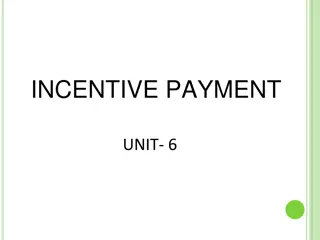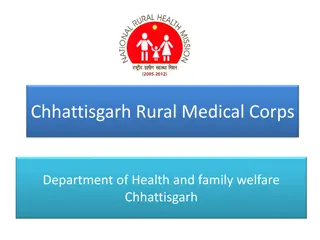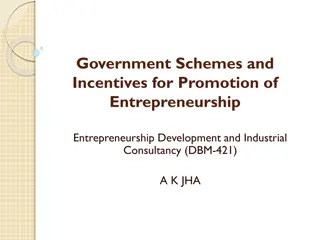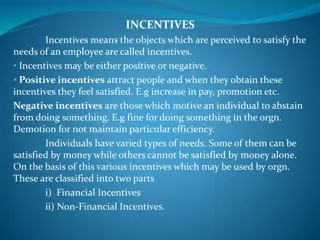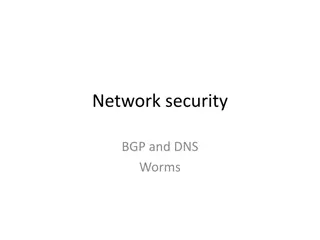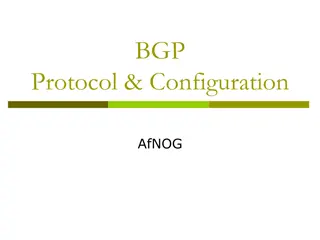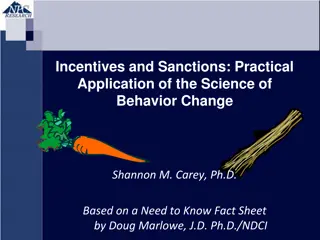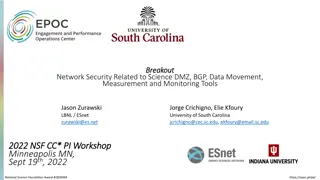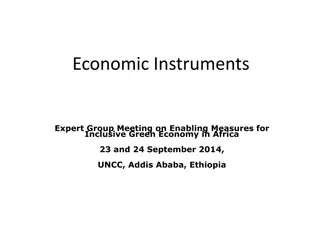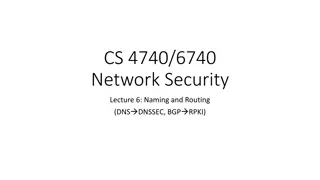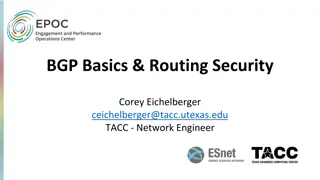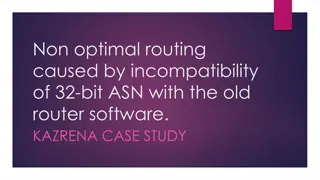Transitioning to BGP Security: Incentives and Challenges
Explore the strategies and incentives for transitioning to BGP security in internet routing, including the use of S*BGP to attract traffic and mitigate interception attacks. Learn about RPKI as a key infrastructure and the need for additional security measures beyond RPKI. Discover how S*BGP can help prevent malicious routing attacks and enhance overall network security.
Download Presentation

Please find below an Image/Link to download the presentation.
The content on the website is provided AS IS for your information and personal use only. It may not be sold, licensed, or shared on other websites without obtaining consent from the author.If you encounter any issues during the download, it is possible that the publisher has removed the file from their server.
You are allowed to download the files provided on this website for personal or commercial use, subject to the condition that they are used lawfully. All files are the property of their respective owners.
The content on the website is provided AS IS for your information and personal use only. It may not be sold, licensed, or shared on other websites without obtaining consent from the author.
E N D
Presentation Transcript
SIGCOMM 2011 Toronto, ON Aug. 16, 2011 Let the Market Drive Deployment A Strategy for Transitioning to BGP Security Phillipa Gill University of Toronto Michael Schapira Princeton University Sharon Goldberg Boston University
Incentives for BGP Security Insecurity of Internet routing is well known: S-BGP proposed in 1997 to address many issues Challenges are being surmounted: Political: Rollout of RPKI as a cryptographic root trust Technical: Lots of activity in the IETF SIDR working group The pessimistic view: This is economically infeasible! Why should ISPs bother deploying S*BGP? No security benefits until many other ASes deploy! Worse yet, they can t make money from it! Our view: Calm down. Things aren t so bad. ISPs can use S*BGP to make money by attracting traffic to their network.
Outline Part 1: Background Part 2: Our strategy Part 3: Evaluating our strategy Model Simulations Part 4: Summary and recommendations
Traffic Attraction & Interception Attacks April 2010 : China Telecom intercepts traffic ChinaTel path is shorter ? ChinaTel 66.174.161.0/24 Level3, VZW, 22394 66.174.161.0/24 ISP 1 VZW, 22394 66.174.161.0/24 Level 3 Verizon Wireless China Telecom 22394 66.174.161.0/24 This prefix and 50K others were announced by China Telecom 22394 Traffic for some prefixes was possibly intercepted 66.174.161.0/24
Securing the Internet: RPKI Resource Public Key Infrastructure (RPKI): Certified mapping from ASes to public keys and IP prefixes. ? X RPKI: Invalid! Level3, VZW, 22394 66.174.161.0/24 ChinaTel 66.174.161.0/24 ISP 1 Level 3 Verizon Wireless China Telecom RPKI shows China Telecom is not a valid origin for this prefix. 22394
But RPKI alone is not enough! Resource Public Key Infrastructure (RPKI): Certified mapping from ASes to public keys and IP prefixes. ? Level3, VZW, 22394 66.174.161.0/24 ChinaTel, 22394 66.174.161.0/24 ISP 1 Level 3 Verizon Wireless China Telecom Malicious router can pretend to connect to the valid origin. 22394
To stop this attack, we need S*BGP (e.g. S-BGP/soBGP) (1) S-BGP [1997]: RPKI + Cannot announce a path that was not announced to you. VZW: (22394, Prefix) Level3: (VZW, 22394, Prefix) ISP 1: (Level3, VZW, 22394, Prefix) ISP 1 Level 3 Verizon Wireless China Telecom VZW: (22394, Prefix) Level3: (VZW, 22394, Prefix) 22394 VZW: (22394, Prefix) Public Key Signature: Anyone with 22394 s public key can validate that the message was sent by 22394.
To stop this attack, we need S*BGP (e.g. S-BGP/soBGP) (2) S-BGP [1997]: RPKI + Cannot announce a path that was not announced to you. VZW: (22394, Prefix) Level3: (VZW, 22394, Prefix) ISP 1: (Level3, VZW, 22394, Prefix) ISP 1 Level 3 Verizon Wireless China Telecom Malicious router can t announce a direct path to 22394, since 22394 never said 22394 ChinaTel: (22394, Prefix)
Overview S*BGP will necessarily go through a transition phase How should deployment occur? Our Goal: Come up with a strategy for S*BGP (S-BGP/soBGP) deployment. How governments & standards groups invest resources to create market pressure for S*BGP deployment We evaluate guidelines via a model & simulations Model: ISPs care only about revenue, not security! And run simulations on [UCLA Cyclops+IXP] AS graph data Parallelize simulations on a 200-node DryadLINQ cluster
Outline Part 1: Background Part 2: Our strategy Part 3: Evaluating our strategy Model Simulations Part 4: Summary and recommendations
How to deploy S*BGP globally? Pessimistic view: No local economic incentives; only security incentives Like IPv6, but worse, because entire path must be secure Our view: S*BGP has an advantage: it affects route selection Route selection controls traffic flows And an ISP that attracts more customer traffic earns more revenue. Why should I upgrade if (security) benefits don t kick in unless everyone else does? 8359
Stubs vs ISPs: Stubs are 85% of the Internets ASes! A stub is an AS with no customers. Stubs shouldn t transit traffic. They only originate their own prefixes. ISP ISP ISP Sprint 8359 13789 $ $ Stub X 18608 Loses $$! 85% of ASes are stubs! We call the rest (15%) ISPs.
How can we create market pressure? Assume that secure ASes break ties on secure paths! 8359, 18608 38.101.185.0/24 13789, 18608 38.101.185.0/24 ISP ISP ISP Sprint 8359 13789 $ $ AS 8359 attracts customer traffic Stub 18608 18608 18608 38.101.185.0/24 38.101.185.0/24 ISPs can use S*BGP to attract customer traffic & thus money
How can we create market pressure? Assume that secure ASes break ties on secure paths! 8359, 18608 38.101.185.0/24 13789: (18608, 38.101.185.0/24) Sprint: (13789, 18608, 38.101.185.0/24) Sprint 8359 13789 AS 8359 loses traffic, feels pressure to deploy. $ $ 13789: (18608, 38.101.185.0/24) 18608 18608 38.101.185.0/24
Our Strategy: 3 Guidelines for Deploying S*BGP (1) 1. Secure ASes should break ties in favor of secure paths 2. ISPs help their stub customers deploy simplex S*BGP. Bank of A Bank of A ISP1 A stub is an AS that does not transit traffic. 85% of ASes are stubs! Boston U Boston U
Simplex S*BGP: `Cheap S*BGP for Stubs A stub never transits traffic Only announces its own prefixes.. and receives paths from provider Sign but don t verify! (rely on provider to validate) 18608 38.101.185.0/24 Stub 18608 2 options for deploying S*BGP in stubs: 1. Have providers sign for stub customers. (Stubs do nothing) 2. Stubs run simplex S*BGP. (Stub only signs, provider validates) 1. No hardware upgrade required Sign for ~1 prefix, not ~300K prefixes Use ~1 private key, not ~36K public keys 2. Security impact is minor (we evaluated this): Stub vulnerable to attacks by its direct provider.
Our Strategy: 3 Guidelines for Deploying S*BGP (2) 1. Secure ASes should break ties in favor of secure paths 2. ISPs help their stub customers deploy simplex S*BGP. Bank of A ISP1 Boston U (possibly with some government subsidies) 3. Initially, a few early adoptersdeploy S*BGP (gov t incentives, regulations, altruism, etc).
Outline Part 1: Background Part 2: Our strategy Part 3: Evaluating our strategy Model Simulations Part 4: Summary and recommendations
A model of the S*BGP deployment process To start the process: Early adopter ASes have deployed S*BGP Their stub customers deploy simplex S*BGP Each round: Compute utility for everyinsecure ISP If its s utility can increase by more than % when it deploys S*BGP, Then SP n decides to secure itself & all its stub customers ISP n ISP n ISP n Stop when no new ISPs decide to become secure.
How do we compute utility? traffic $ Number of source ASes routing through ISP n to all customer destinations. ISP n ISP n $ Important Note: ISP utility does not depend on security. BGP Routing Policy Model: 1. Prefer customer paths over peer paths over provider paths 2. Prefer shorter paths To determine routing, we run simulations on the [UCLA Cyclops] AS graph with these routing policies: 3. . 4. If secure, prefer secure paths Arbitrary tiebreak
Outline Part 1: Background Part 2: Our strategy Part 3: Evaluating our strategy Model Simulations Part 4: Summary and recommendations
Case Study of S*BGP deployment Ten early adopters: Five Tier 1s: Sprint (AS 1239) Verizon (AS 701) AT&T (AS 7018) Level 3 (AS 3356) Cogent (AS 174) Five Popular Content Providers Google (AS 15169) Microsoft (AS 8075) Facebook (AS 32934) Akamai (AS 22822) Limelight (AS 20940) The five content providers source 10% of Internet traffic Stubs break ties in favor of secure paths Threshold = 5%. This leads to 85% of ASes deploying S*BGP (65% of ISPs)
Simulation: Market pressure drives deployment (1) Round 0 Round 1 Round 4 Sprint 13789 13789 8359 8359 18608 18608 Stub
Simulation: Market pressure drives deployment (2) Round 4 Round 5 Sprint 8342 13789 8359 18608 6731 6731 30733 Stub 50197 50197 Stub
Simulation: Market pressure drives deployment (3) Round 6 Round 7 Sprint 8342 8342 13789 8359 18608 9002 6731 6731 30733 Stub 50197 50197 41209 41209 43975 Stub Stub 39575 39575
So who should be the early adopters? Theorem: Finding the optimal set of early adopters is NP-hard. Approximating this within a constant factor is also NP-hard.
So who should be the early adopters? Small target set suffices for small threshold Higher threshold requires a larger target set. Easy to deploy Hard to deploy
Outline Part 1: Background Part 2: Our strategy Part 3: Evaluating our strategy Model Simulations Part 4: Summary and recommendations
Summary and Recommendations How to create a market for S*BGP deployment? 1. Many secure destinations via simplex S*BGP. 2. Market pressure via S*BGP influence on route selection. Where should government incentives and regulation go? 1. Focus on early adopters; Tier 1s, maybe content providers 2. Subsidize ISPs to upgrade stubs to simplex S*BGP Other challenges and future work : ISPs can have incentives to turn off S*BGP BGP and S*BGP will coexist in the long run ISPs need tools to predict S*BGP impact on traffic
Contact: phillipa@cs.toronto.edu http://www.cs.toronto.edu/~phillipa/sbgpTrans.html Thanks to Microsoft Research SVC and New England for supporting us with DryadLINQ.
Data Sources for ChinaTel Incident of April 2010 Example topology derived from Routeviews messages observed at the LINX Routeviews monitor on April 8 2010 BGP announcements & topology was simplified to remove prepending We anonymized the large ISP in the Figure. Actual announcements at the large ISP were: From faulty ChinaTel router: 4134 23724 23724 for 66.174.161.0/24 From Level 3: 3356 6167 22394 22394 for 66.174.161.0/24 Traffic interception was observed by Renesys blog http://www.renesys.com/blog/2010/11/chinas-18-minute-mystery.shtml We don t have data on the exact prefixes for which this happened. AS relationships: inferred by UCLA Cyclops








